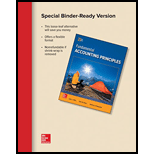
Concept Introduction:
Inventory Turnover Ratio: Inventory Turnover Ratio measures the efficiency of the company in converting its inventory into sales. It is calculated by dividing the Cost of goods sold by Average inventory. The formula of the Inventory Turnover Ratio is as follows:
Note: Average inventory is calculated with the help of following formula:
Day’s sales in inventory: Days sales in inventory represent the number of days the inventory waits for the sale. It is calculated by dividing the 365 days by Inventory Turnover Ratio. The formula of the Days sales in inventory is as follows:
To determine: The Inventory turnover ratio and days sales in inventory for 2017 and 2016 and comment on the company’s efficiency to increase sales from 2016 to 2017.
Want to see the full answer?
Check out a sample textbook solution
Chapter 6 Solutions
Loose Leaf for Fundamental Accounting Principles
- Treadway Equipment acquired manufacturing machinery at the beginning of the year at a cost of $86,000. The machinery has an estimated residual value of $5,500 and an estimated useful life of 5 years. Determine the second-year depreciation using the straight-line method.arrow_forwardHow can I solve this financial accounting problem using the appropriate financial process?arrow_forwardThe ending balance of the direct materials inventory is $_.arrow_forward
- What are adjusting journal entries and why are they necessary? Meedarrow_forwardno ai What are adjusting journal entries and why are they necessary?arrow_forwardLawrence Industries plans to produce 30,000 units next period at a denominator activity of 45,000 direct labor hours. The direct labor wage rate is $16.00 per hour. The company's standards allow 2.2 yards of direct materials for each unit of product; the material costs $8.50 per yard. The company's budget includes a variable manufacturing overhead cost of $3.25 per direct labor hour and fixed manufacturing overhead of $270,000 per period. Using 45,000 direct labor hours as the denominator activity, compute the predetermined overhead rate and break it down into variable and fixed elements.arrow_forward

 AccountingAccountingISBN:9781337272094Author:WARREN, Carl S., Reeve, James M., Duchac, Jonathan E.Publisher:Cengage Learning,
AccountingAccountingISBN:9781337272094Author:WARREN, Carl S., Reeve, James M., Duchac, Jonathan E.Publisher:Cengage Learning, Accounting Information SystemsAccountingISBN:9781337619202Author:Hall, James A.Publisher:Cengage Learning,
Accounting Information SystemsAccountingISBN:9781337619202Author:Hall, James A.Publisher:Cengage Learning, Horngren's Cost Accounting: A Managerial Emphasis...AccountingISBN:9780134475585Author:Srikant M. Datar, Madhav V. RajanPublisher:PEARSON
Horngren's Cost Accounting: A Managerial Emphasis...AccountingISBN:9780134475585Author:Srikant M. Datar, Madhav V. RajanPublisher:PEARSON Intermediate AccountingAccountingISBN:9781259722660Author:J. David Spiceland, Mark W. Nelson, Wayne M ThomasPublisher:McGraw-Hill Education
Intermediate AccountingAccountingISBN:9781259722660Author:J. David Spiceland, Mark W. Nelson, Wayne M ThomasPublisher:McGraw-Hill Education Financial and Managerial AccountingAccountingISBN:9781259726705Author:John J Wild, Ken W. Shaw, Barbara Chiappetta Fundamental Accounting PrinciplesPublisher:McGraw-Hill Education
Financial and Managerial AccountingAccountingISBN:9781259726705Author:John J Wild, Ken W. Shaw, Barbara Chiappetta Fundamental Accounting PrinciplesPublisher:McGraw-Hill Education





